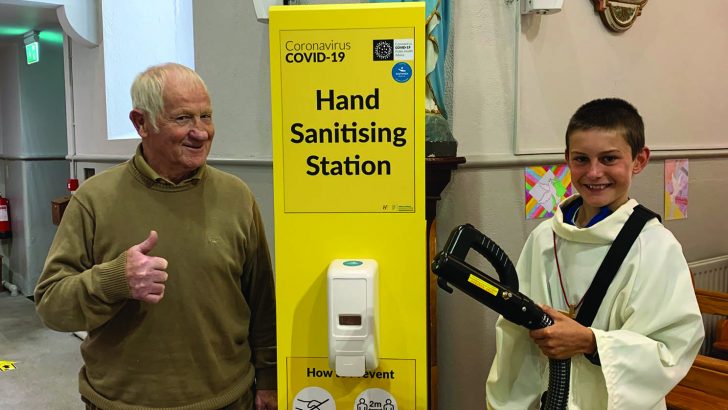New research which reveals that congregations could fall by as much as a quarter should serve as a wake-up call to all of us writes Michael Kelly
It’s more than six months since restrictions were first imposed on the celebration of public Masses in a bid to slow the spread of the coronavirus. Many parishes and communities responded swiftly and with creativity. Webcams that had already been installed and had been a lifeline for parishioners living abroad to, for example, participate in funeral liturgies were now the staple for Sunday Mass. Elsewhere, platforms like Facebook Live and YouTube were utilised to ensure that the Mass was available to a new virtual congregation.
It worked admirably well for what it is, but people sitting around individually at their kitchen table is a poor substitute for the collective celebration of the Eucharist in our sacred places.
Masses
While many parishes have now had public Masses since late June, restrictions on the number of people who can attend remain in place. This has obviously affected the ability of some people to attend, but fear of Covid-19 has also been a significant factor in people choosing to stay away according to new research.
The poll – conducted by Amárach Research on behalf of The Iona Institute – asked Catholics whether they attended Mass prior to coronavirus coming to our shores and the consequent restrictions. It found that 27% of Catholics reported that they did attend Mass regularly. This is still one of the highest rates of Mass attendance in Europe, but down from a consistent result of around a third of Catholics saying they go to Mass regularly in the past few years.
These people who reported that they were regular Massgoers before the pandemic were then asked whether or not they had returned to Mass since restrictions were lifted. The research found that 36% of those who attended pre-coronavirus are now back attending Mass regularly. While this figure may seem low, it should be borne in mind that restrictions still in place mean that many churches can only allow 50 congregants to gather for Mass.
Data
At the same time, the data reveals that most Massgoers are over the age of 65 and this is the age group that the Government insists is most vulnerable to the virus.
But, what of the almost two thirds of pre-pandemic Massgoers who are not attending?
The pollsters asked the 64% of people who reported that they have not returned to Mass why this was the case. Predictably, fear of the virus was the number one reason. However, some other interesting reasons were revealed. Fear of Covid-19 was given as the reason for 46% of people. A further 22% – also unsurprisingly – said that they were staying away because of ongoing limits on the size of congregations. A not insignificant minority – 7% – said they had simply lost the habit of going to Mass while six percent reported that they are happy enough with the experience of continuing to participate in the liturgy online.
One in five – 20% – offered another reason or said they didn’t know why they were not currently going to Mass. Other reasons included people who said they didn’t want to take up one of the limited places so as to exclude others (4%), the inability to attend due to parental/work responsibilities (4%) and the local church remaining closed (2%).
Perhaps more interestingly, pre-pandemic Massgoers who are not currently attending were asked whether or not they will return to the regular practice of their faith once coronavirus-related restrictions are lifted. Just 4% said they will not come back. However, a figure that is likely to prove more vexing for Church leaders is that 19% – almost one in five – of those who attended Mass before restrictions say they do not know whether they will come back when things get back to normal.
If, for example, that was borne out in reality and those 19% of people did not return added to the four percent who said they were certain they would not come back, we could see congregations fall by as much as a quarter.
Survey
Consistently, when people are surveyed and asked why they have not become involved in a particular club or activity the response is some variation of “I wasn’t asked”.
This should serve as a significant wake-up call that parish communities will have to be proactive in inviting people to return. Perhaps when things do eventually settle down, parishes might consider organising a community Mass of thanksgiving. Homes could be leafleted and advertisements taken in local newspapers with a personal invitation for people to come back. As well as reaching those who were with us before the pandemic, it could even have an impact on helping people who have long since given up going to Mass to return and be part of the congregation.
“The Church is clearly going to have to organise a big parish-by-parish effort and invite those people them back – the Church is nothing if it is not a community. We can’t be Christians on their own,” he said.


 Michael Kelly
Michael Kelly Local parishioner Willie Carley gives
the ‘thumbs up!’ to altar server and
confirmation candidate Rory Goff who checks out ‘the fogger’ which is being
used between Masses to sanitise the church at Glynn, Co. Wexford.
Local parishioner Willie Carley gives
the ‘thumbs up!’ to altar server and
confirmation candidate Rory Goff who checks out ‘the fogger’ which is being
used between Masses to sanitise the church at Glynn, Co. Wexford. 